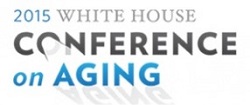
Guest blogger Priscilla (Pris) Rogers, Ph.D. is the Program Manager for VisionAware and co-author of Aging and Vision Loss: A Handbook for Families. Her other works include Self-Advocacy Skills Training for Older Individuals Who Are Visually Impaired and Solutions for Success: A Training Manual for Working with Older People Who Are Visually Impaired. She has an M.A. degree in gerontology and a Ph.D. in special education with an emphasis in vision and aging.
First, Some Background and an Overview
The White House Conference on Aging (WHCOA) took place on July 13, 2015. It was an historic occasion that occurs once a decade. The 2015 conference was the first to take place on a national stage with the opportunity for people across the nation – and even the world – to listen in and participate through social media, including a Twitter feed @WHAging that enabled virtual attendees to ask questions and make comments.

The American Foundation for the Blind’s (AFB) Letter to the President: 2015 White House Conference on Aging articulated major WHCOA issues related to aging and vision loss. AFB and the 80+ agencies that signed on to the letter emphasized the need for a systemic approach to ensure that older Americans who are blind or visually impaired are able to (a) receive the training in independent living they need to carry out everyday tasks, (b) obtain critical technologies to enhance their health, independence and safety, and (c) access appropriate support services, such as transportation.
A Summary of the White House Conference on Aging Issues and Initiatives
In A Summary of the White House Conference on Aging Issues and Initiatives: Part One, Pris described the major issues and initiatives addressed during the 2015 White House Conference on Aging (WHCOA). In Part Two, she summarized the conference initiatives related to aging and vision loss addressed by the American Foundation for the Blind’s Letter to the President. In Part Three, Pris concluded her discussion of the conference initiatives with additional remarks related to aging and vision loss that were also addressed in AFB’s Letter to the President
The VisionAware Response to the White House Conference on Aging Final Report
We applaud the White House Conference on Aging Final Report for targeting issues that affect older persons who are experiencing vision loss as a result of age-related eye conditions, as well as people who have had vision problems all of their lives and who may need additional assistance as they age.
A National Conversation
To participate in the “conversation” and to ensure that older Americans with vision loss had a “voice” in the proceedings, AFB held a national conversation about the major issues on which the conference focused: healthy aging, long term services and supports, elder justice, and retirement security. AFB also invited older persons with vision loss, their family members and caregivers, and service providers to comment on these issues through an online survey.
Many major concerns were raised, some of which are addressed, in part, by the federal, state, and private sector initiatives outlined in the White House Conference on Aging Final Report. However, despite the large numbers of older persons experiencing vision loss in this country, only one mention of vision loss was made in the entire report:
Some commenters expressed concern about the lack of preventive benefits in Medicare to provide for dental, hearing, and vision care. The loss of hearing and vision can be major challenges to older adults to remain independent, and can contribute to increased social isolation.
Preventive Care and the Low Vision Devices Act of 2015
The issue raised about preventive benefits is a very important one and needs to be addressed. In fact, the Medicare Demonstration of Coverage for Low Vision Devices Act of 2015 (H.R.729) has been filed in the U.S. House of Representatives to address the need for Medicare to cover much-needed low vision devices. [Please note: As of this writing, H.R.729 has no companion bill in the Senate.]
H.R.729 “… directs the Secretary of Health and Human Services to commence a project to demonstrate and evaluate the fiscal impact of covering low vision devices under part B (Supplementary Medical Insurance) of title XVIII (Medicare) of the Social Security Act in the same or similar manner as coverage is provided for durable medical equipment under such part.” [Please note: You can read about the prior Medicare Demonstration of Coverage for Low Vision Devices Act of 2013: H.R.3749 on the VisionAware blog.]
However, there were no specific responses to AFB’s Letter to the President and White House Conference staff regarding our findings, a letter which over 80 agencies in the field of vision rehabilitation co-signed and which was also sent to members of Congress and key personnel in the administration.
A Quote from the White House Conference on Aging Final Report
This quote from the White House Conference on Aging Final Report sums up what ought to happen for every older American:
Moving forward, we need to appreciate our demographic changes, collaborate across sectors, focus renewed efforts on paid and unpaid caregiving and, most importantly, foster a cultural change in Americans’ attitudes about aging. In doing so, we can help every individual enjoy a longer, better, more active, and more independent life. We need to effectively engage the challenges and embrace the possibilities that are inherent in a rapidly aging population and ensure that all Americans can better age well and live well. Contributing to our society and communities in a meaningful way — that will be the new definition of aging in America as we go forward.
Older persons with vision problems should not be sidelined or forgotten because of their inability to engage – due to transportation issues, lack of technology access, and/or lack of vision rehabilitation services.
As we noted in our letter:
- The primary health programs serving older Americans, Medicare and Medicaid, do not cover technology and specialized services (e.g. low vision devices, rehabilitation therapy, etc.) for older Americans who are blind or visually impaired. A common refrain we heard is reflected in the following quotation: “Aids for vision such as glasses, magnifiers, and talking devices should be covered. This could mean the difference between a person being independent and having to have a family member, or needing to hire someone, to provide these services.”
- Service delivery systems addressing the needs of older Americans are fragmented and poorly coordinated. The federal and local agencies that support rehabilitation services for older people too often do not coordinate with agencies that provide aging services and vice versa.
- Funding for specialized services for older adults with vision loss is insufficient. Important services do not reach many of those who have the greatest need of assistance – including those in rural areas, those who are isolated from social and family networks, and those who have additional disabilities and medical conditions (especially deafness/hearing loss, memory loss, and diabetes).
- At a minimum, full funding is needed for the Older Individuals Who are Blind (OIB) Program, a federal program authorized by the Vocational Rehabilitation Act and administered through vocational rehabilitation services in each state.
- The number of qualified professionals providing supports for adults with vision loss is vastly inadequate to meet the service delivery needs of the growing population of older Americans with vision loss. Targeted funds are needed to support training and employment of vision professionals, as well as to provide pre-service and in-service training for service providers, caregivers, and healthcare workers who provide in-home, community-based, and residential services.
- Older Americans with vision loss can continue to live independent and fulfilling lives if given access to appropriate home and community-based supports for carrying out everyday tasks. Seniors should have access to qualified, trusted assistance for reviewing printed materials and managing finances in a way that respects their independence and privacy. Additionally, all Americans – particularly seniors – benefit from affordable, reliable public transportation access, not only for medical appointments and groceries, but for social activities, visiting family, and pursuing their retirement goals and aspirations.
- Economic security is even more precarious among older Americans who are likely to have had fewer employment opportunities or to have retired early due to unexpected vision loss. These individuals significantly economically disadvantaged as a direct result of their vision loss.
- To ensure equal access, overcome employment barriers, and promote the highest possible quality of life for Americans who are visually impaired, we must have a fundamental improvement in the public understanding and acceptance of low vision and blindness – from retail product and service providers to medical practitioners to policymakers. …Existing Older Americans Act (OAA) public education programs should include information about older persons with vision loss.
A Summary
The bottom line is that older persons with vision loss, who represent over 13% of the older population (2010 United States Census), are effectively disenfranchised. There is clearly a major need for developing a systemic approach to ensure they are included and represented in national initiatives going forward that involve strategies for addressing increasing availability of services that increase independent living options, obtaining critical technologies to enhance their health, independence, and safety, and accessing appropriate support services such as transportation.
For More Information
Information on the WHCOA initiatives was excerpted from Fact Sheet: The White House Conference on Aging.